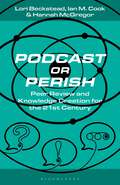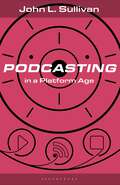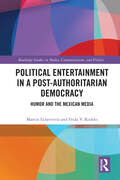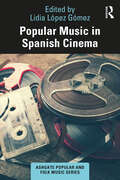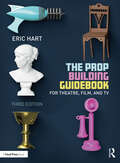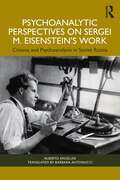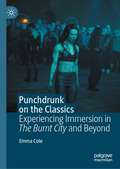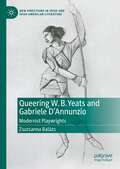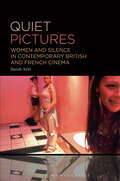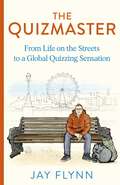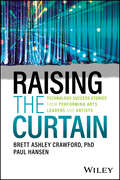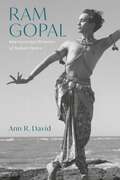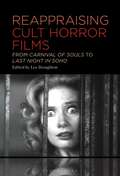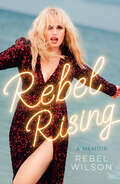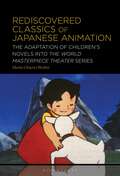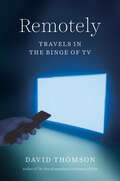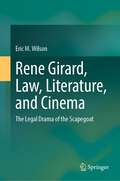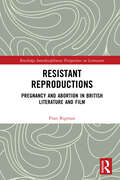- Table View
- List View
Podcast or Perish: Peer Review and Knowledge Creation for the 21st Century (Bloomsbury Podcast Studies)
by Lori Beckstead Ian M. Cook Hannah McGregorPodcasting scholarship is still in its nascent stages. The use of podcasting as a tool for scholarly and intellectual inquiry is a relatively new idea, to think about the medium as an alternative outlet for research output. Podcast or Perish maps out not simply a rationale for the deployment of podcasting as an outlet for open peer review, but also explores some real-world workflows for such a practice.At the forefront of merging these exciting fields, Lori Beckstead, Ian M. Cook, and Hannah McGregor have taken a novel approach to expanding the boundaries of scholarly knowledge by considering podcasting as a focal point for intellectual discussion, engagement, and exploration. By investigating the historical development of the norms of scholarly communication, the unique affordances of sound-based scholarship, and the transformative potential of new modes of knowledge production, Podcast or Perish is the call to action academia needs, by asking how podcasting might change the very ways we think about scholarly work.
Podcasting in a Platform Age: From an Amateur to a Professional Medium (Bloomsbury Podcast Studies)
by John L. SullivanPodcasting in a Platform Age explores the transition underway in podcasting by considering how the influx of legacy and new media interest in the medium is injecting professional and corporate logics into what had been largely an amateur media form. Many of the most high-profile podcasts today, however, are produced by highly-skilled media professionals, some of whom are employees of media corporations. Legacy radio and new media platform giants like Google, Apple, Amazon, and Spotify are also making big (and expensive) moves in the medium by acquiring content producers and hosting platforms. This book focuses on three major aspects of this transformation: formalization, professionalization, and monetization. Through a close read of online and press discourse, analysis of podcasts themselves, participant observations at podcast trade shows and conventions, and interviews with industry professionals and individual podcasters, John Sullivan outlines how the efforts of industry players to transform podcasting into a profitable medium are beginning to challenge the very definition of podcasting itself.
Political Entertainment in a Post-Authoritarian Democracy: Humor and the Mexican Media (Routledge Studies in Media, Communication, and Politics)
by Martin Echeverria Frida V. RodeloThe book offers an analytical and empirical account of the specificities of political entertainment in post-authoritarian democracies. Centered around Mexico as a case study, the book explores the production of political entertainment in post-authoritarian legacy media and how political and economic conditions constrain the range and edge of discourse; how political entertainment in social media is shaped by the structure of platforms, as creators are encouraged to conform to specific norms such as constant publication; and the impacts of these media on attitude formation among the population. The book proposes a theoretical framework for identifying the specific conditions of post-authoritarian democracies that constrain the production of political entertainment, as well as its outcomes in terms of content and effects. This framework can be applied to the analysis of similar case studies, particularly in the Global South at large. With an analysis drawing on hard data, historical accounts, and anecdotal evidence, this volume will resonate within academic communities interested in political communication, media studies, transitional democracies, and popular culture.
Political Entertainment in a Post-Authoritarian Democracy: Humor and the Mexican Media (Routledge Studies in Media, Communication, and Politics)
by Martin Echeverria Frida V. RodeloThe book offers an analytical and empirical account of the specificities of political entertainment in post-authoritarian democracies. Centered around Mexico as a case study, the book explores the production of political entertainment in post-authoritarian legacy media and how political and economic conditions constrain the range and edge of discourse; how political entertainment in social media is shaped by the structure of platforms, as creators are encouraged to conform to specific norms such as constant publication; and the impacts of these media on attitude formation among the population. The book proposes a theoretical framework for identifying the specific conditions of post-authoritarian democracies that constrain the production of political entertainment, as well as its outcomes in terms of content and effects. This framework can be applied to the analysis of similar case studies, particularly in the Global South at large. With an analysis drawing on hard data, historical accounts, and anecdotal evidence, this volume will resonate within academic communities interested in political communication, media studies, transitional democracies, and popular culture.
Popular Music in Spanish Cinema (Ashgate Popular and Folk Music Series)
by Lidia López GómezPopular Music in Spanish Cinema analyses the aesthetics and stylistic development of soundtracks from national productions, considering how political instability and cultural diversity in Spain determined the ways of making art and managing culture. As a pioneering study in this field, the chronologically structured approach of this book provides readers with a complete overview of Spanish music and connects it to the complex historical events that conditioned Spanish culture throughout the 20th century to the present day, from the Second Republic, the Spanish Civil war, and the dictatorship through to democracy. The book enables an understanding of the relationships between the recording and film production industries, the construction of collective imagination, the formulation of new stereotypes, semiotic meanings within film music and the musical exchanges between national and international cinema. This volume is an essential read for students and academics in the field of musicology, ethnomusicology and history as well as those interested in the study of diverse musical styles such as copla, zarzuela, flamenco, jazz, foxtrot, pop and rock and how they have been used in Spanish films throughout history.
Popular Music in Spanish Cinema (Ashgate Popular and Folk Music Series)
Popular Music in Spanish Cinema analyses the aesthetics and stylistic development of soundtracks from national productions, considering how political instability and cultural diversity in Spain determined the ways of making art and managing culture. As a pioneering study in this field, the chronologically structured approach of this book provides readers with a complete overview of Spanish music and connects it to the complex historical events that conditioned Spanish culture throughout the 20th century to the present day, from the Second Republic, the Spanish Civil war, and the dictatorship through to democracy. The book enables an understanding of the relationships between the recording and film production industries, the construction of collective imagination, the formulation of new stereotypes, semiotic meanings within film music and the musical exchanges between national and international cinema. This volume is an essential read for students and academics in the field of musicology, ethnomusicology and history as well as those interested in the study of diverse musical styles such as copla, zarzuela, flamenco, jazz, foxtrot, pop and rock and how they have been used in Spanish films throughout history.
The Prop Building Guidebook: For Theatre, Film, and TV
by Eric HartNow in its third edition, The Prop Building Guidebook: For Theatre, Film, and TV walks readers through techniques used in historical and contemporary prop making and demonstrates how to apply them to a variety of materials. Experienced prop maker Eric Hart covers the tools and techniques used by professional prop makers throughout the entertainment industry. He outlines a construction process that gives readers the foundational knowledge to choose the best materials and methods for each prop and the background information to know the advantages of these choices. This new edition includes updated information and techniques throughout, including: Over a hundred new images and diagrams Updated terminology, products, and brands used internationally Expanded sections on 3D printing, vacuum forming, foam patterning, and more A new chapter on prop design New information on international safety standards, cleaning, and sanitation More recipes and step-by-step instruction for various finishes Illustrated by hundreds of full-color photographs, this is the most comprehensive guide to prop construction available for professional and student prop makers in theatre, film, and tv. For additional how-to videos, instructional documents, and supplemental information, visit www.propbuildingguidebook.com.
The Prop Building Guidebook: For Theatre, Film, and TV
by Eric HartNow in its third edition, The Prop Building Guidebook: For Theatre, Film, and TV walks readers through techniques used in historical and contemporary prop making and demonstrates how to apply them to a variety of materials. Experienced prop maker Eric Hart covers the tools and techniques used by professional prop makers throughout the entertainment industry. He outlines a construction process that gives readers the foundational knowledge to choose the best materials and methods for each prop and the background information to know the advantages of these choices. This new edition includes updated information and techniques throughout, including: Over a hundred new images and diagrams Updated terminology, products, and brands used internationally Expanded sections on 3D printing, vacuum forming, foam patterning, and more A new chapter on prop design New information on international safety standards, cleaning, and sanitation More recipes and step-by-step instruction for various finishes Illustrated by hundreds of full-color photographs, this is the most comprehensive guide to prop construction available for professional and student prop makers in theatre, film, and tv. For additional how-to videos, instructional documents, and supplemental information, visit www.propbuildingguidebook.com.
Psychoanalytic Perspectives on Sergei M. Eisenstein's Work: Cinema and Psychoanalysis in Soviet Russia
by Alberto AngeliniIn this insightful book, Alberto Angelini shows the influence of psychoanalysis and psychology on Sergei M. Eisenstein, one of the most celebrated Russian directors, and his cinematic output. Angelini situates Eisenstein’s life and oeuvre in the history and culture of twentieth-century Russia, drawing clear parallels between his networking with key figures such as Lev Vygotsky and Aleksandr Luria. He utilises the tools of psychology with the insight of psychoanalysis to illuminate the ways in which Eisenstein understood art as an anthropological enterprise while maintaining the same dialectical philosophy as the director in highlighting the many disciplines and figures that he drew inspiration from. Angelini also looks in depth at the influence psychoanalytic theories of regression had on Eisenstein’s approach to art, while examining the impact Stalinism had directly on both Eisenstein and psychoanalysis at large from the 1930s onwards. This book is an essential resource for psychoanalysts, students, and scholars of film studies, as well as those interested in the intersection between psychoanalytic theory, cinema, and the arts.
Psychoanalytic Perspectives on Sergei M. Eisenstein's Work: Cinema and Psychoanalysis in Soviet Russia
by Alberto AngeliniIn this insightful book, Alberto Angelini shows the influence of psychoanalysis and psychology on Sergei M. Eisenstein, one of the most celebrated Russian directors, and his cinematic output. Angelini situates Eisenstein’s life and oeuvre in the history and culture of twentieth-century Russia, drawing clear parallels between his networking with key figures such as Lev Vygotsky and Aleksandr Luria. He utilises the tools of psychology with the insight of psychoanalysis to illuminate the ways in which Eisenstein understood art as an anthropological enterprise while maintaining the same dialectical philosophy as the director in highlighting the many disciplines and figures that he drew inspiration from. Angelini also looks in depth at the influence psychoanalytic theories of regression had on Eisenstein’s approach to art, while examining the impact Stalinism had directly on both Eisenstein and psychoanalysis at large from the 1930s onwards. This book is an essential resource for psychoanalysts, students, and scholars of film studies, as well as those interested in the intersection between psychoanalytic theory, cinema, and the arts.
Punchdrunk on the Classics: Experiencing Immersion in The Burnt City and Beyond
by Emma ColePunchdrunk on the Classics: Experiencing Immersion in The Burnt City and Beyond draws attention to Punchdrunk’s use of ancient Greek literature in their creation of immersive theatre. The book documents and analyses the effects of utilising Greek tragedy within both Punchdrunk’s creative development windows, and the company’s final staged productions. It features material stretching from The House of Oedipus (2000) right through to The Burnt City (2022-23), on which the author worked as dramaturg. Chapters include rehearsal studies, explorations of how Greek literature can shape an audience’s experience in immersive theatre, and considerations of how The Burnt City might change our understanding of the poetics of immersion in antiquity. Overall, Punchdrunk on the Classics provides an unparalleled depth of insight into an individual Punchdrunk production, and highlights the until-now overlooked significance of antiquity within Punchdrunk’s practice.
Quebec Cinema in the 21st Century: Transcending the National (Contemporary French and Francophone Cultures #95)
by Michael Gott and Thibaut SchiltThis collection of ten chapters and three original interviews with Québécois filmmakers focuses on the past two decades of Quebec cinema and takes an in-depth look at a (primarily) Montreal-based filmmaking industry whose increasingly diverse productions continue to resist the hegemony of Hollywood and to exist as a visible and successful hub of French-language – and ever more multilingual – cinema in North America. This volume picks up where Bill Marshall’s 2001 Quebec National Cinema ends to investigate the inherently global nature of Quebec’s film industry and cinematic output since the beginning of the new millennium. Through their analyses of contemporary films (Une colonie, Avant les rues, Bon cop, bad cop, Les Affamés, Tom à la ferme, Uvanga, among others), directors (including Xavier Dolan, Denis Côté, Sophie Desrape, Chloé Robichaud, Jean-Marc Vallée, and Monia Chokri) and genres (such as the buddy comedy and the zombie film), our authors examine the growing tension between Quebec cinema as a “national cinema” and as an art form that reflects the transnationalism of today’s world, a new form of fluidity of individual experiences, and an increasing on-screen presence of Indigenous subjects, both within and outside the borders of the province. The book concludes with specially conducted interviews with filmmakers Denis Chouinard, Bachir Bensadekk, and Marie-Hélène Cousineau, who provide their views and insights on contemporary Quebec filmmaking.
Queering W. B. Yeats and Gabriele D’Annunzio: Modernist Playwrights (New Directions in Irish and Irish American Literature)
by Zsuzsanna BalázsQueering W. B. Yeats and Gabriele D’Annunzio: Modernist Playwrights challenges the general resistance in scholarship and queer studies to approach Yeats and D’Annunzio through a queer lens because of their controversial affiliations with fascism and elitism, their heterosexuality and their venerated canonical status. This book provides the first fully theorised queer and comparative reading of Yeats’s and D’Annunzio’s drama. It offers the novel contention that due to their increasing involvement in queer and feminist subcultures, their plays feature feelings that are associated with queer historiography and generate ideas that began to be theorised by queer studies more than half a century after the composition of the plays. Moreover, it uncovers an alert, subversive and often coded social commentary in eight key dramatic texts by each playwright and at the same time highlights the thus far neglected commonalities between the plays and the queer historical as well as cultural contexts of these two prominent modernists.
Quiet Pictures: Women and Silence in Contemporary British and French Cinema
by Dr. Sarah ArttQuiet Pictures approaches the films of Joanna Hogg, Lynne Ramsay, Céline Sciamma, and Lucile Hadžhalilovicthrough the lens of silence as a motif and texture.This book takes up the question of different uses of silence in the work of these directors and how this creates a space for foregrounding innovative practices that establish new ways of looking, staring, and gazing. Sarah Artt discusses how the deliberate deployment of silence creates space for the formation of reciprocal gazes that counteract the typically gendered and binary ways in which women and femme-presenting people tend to be portrayed on screen. Quiet Pictures draws on the political legacy of feminist film theory to explore and conceptualise what it means to not just look back, but to share the gaze. This book discusses several films, including: Unrelated (Hogg, 2007), Archipelago (Hogg, 2010), Exhibition (Hogg, 2013), The Souvenir Part I and II (Hogg, 2019 and 2021), Morvern Callar (Ramsay, 2002), We Need to Talk About Kevin (Ramsay, 2011), Innocence (Hadžhalilovic 2004), Evolution (Hadžhalilovic 2015), Waterlilies/Naissance des Pieuvres (Sciamma, 2007), Tomboy (Sciamma, 2011), Girlhood/Bande des Filles (Sciamma, 2014), Portrait of a Lady on Fire/Portrait d'une jeune fille en feu (Sciamma, 2019), and Petite Maman/Little Mother (Sciamma, 2021).
The Quizmaster: From Life on the Streets to a Global Quizzing Sensation
by Jay Flynn** Available to pre-order now **THE HEART-WARMING, REMARKABLE TRUE STORY OF THE QUIZMASTER JAY FLYNN, WHOSE VIRTUAL PUB QUIZ BECAME AN ONLINE SENSATION DURING COVID.Jay Flynn was down on his luck when the Covid pandemic struck. He had just lost the tenancy of the pub he ran in Lancashire - and with it the loyal community of locals who loved his quirky weekly quiz.As the world closed down, he sensed the quiz could now be a lifeline both for him and the locals - so he sent them invites to an online version. But he had forgotten to mark the event 'private', and on the night, a disbelieving Jay played quizmaster to half a million teams, from Kenya to Canada, New Zealand to the Ukraine. This was to be the start of a global online quiz sensation, earning more than £1 million for charity and Jay an MBE, as well as his own slot on Zoe Ball's BBC Radio 2 Breakfast Show.It was all the more incredible because, as a lost and troubled young man, Jay had spent two years homeless, sleeping on a bench on the Embankment in London, almost taking his own life. Rescued by a homeless charity, he'd learnt how a simple community can save lives. It proved a priceless lesson.Now, in his inspiring memoir, Jay shows how, sometimes, you can find the answers you're seeking in the most unexpected places.
Raising the Curtain: Technology Success Stories from Performing Arts Leaders and Artists
by Brett Ashley Crawford Paul HansenLearn how emerging technologies benefit artists and performing arts organizations Raising the Curtain: Technology Success Stories from Performing Arts Leaders and Artists focuses on empowering artists and performing arts organizations in theater, dance, and music to grow audiences and to increase impact through smart and strategic uses of technology. This book will help you effectively increase your artistic and administrative reach in order to expand your outreach to diverse audiences, without breaking the bank. In fact, you’ll be more efficient by choosing multi-function technologies that work for you. You’ll also see how advanced software can extend your donor reach—and ensure that you’re contacting donors at the right time. You can also maximize your organization’s brand by incorporating social media, AI tools, media streaming platforms, and more. Inside, you’ll learn about the most useful tech tools out there, including a wide breadth of technology, from Tessitura to A.I., from the success stories of artists such as Emmet Cohen and Jane Monheit, and organizations such as Attack Theatre and The Kennedy Center. Even more importantly, you’ll gain the confidence you need to incorporate technology into all areas of your organization in order to define your path to greater success. Discover software platforms, online tools, and other interactive technologies useful to designers, artists, and arts organizations Save money, expand your reach, and future-proof your performing arts organization or career Lead conversations about technologies and digital opportunities with staff, board members, or donors Get an overview of technology that addresses the unique opportunities and challenges facing the performing arts industry This book is a great resource for performing arts administrators and artists to learn new ideas about technology solutions. Administrators, leaders, and performers alike will appreciate the opportunity to bring art to audiences using today’s latest innovations.
Raising the Curtain: Technology Success Stories from Performing Arts Leaders and Artists
by Brett Ashley Crawford Paul HansenLearn how emerging technologies benefit artists and performing arts organizations Raising the Curtain: Technology Success Stories from Performing Arts Leaders and Artists focuses on empowering artists and performing arts organizations in theater, dance, and music to grow audiences and to increase impact through smart and strategic uses of technology. This book will help you effectively increase your artistic and administrative reach in order to expand your outreach to diverse audiences, without breaking the bank. In fact, you’ll be more efficient by choosing multi-function technologies that work for you. You’ll also see how advanced software can extend your donor reach—and ensure that you’re contacting donors at the right time. You can also maximize your organization’s brand by incorporating social media, AI tools, media streaming platforms, and more. Inside, you’ll learn about the most useful tech tools out there, including a wide breadth of technology, from Tessitura to A.I., from the success stories of artists such as Emmet Cohen and Jane Monheit, and organizations such as Attack Theatre and The Kennedy Center. Even more importantly, you’ll gain the confidence you need to incorporate technology into all areas of your organization in order to define your path to greater success. Discover software platforms, online tools, and other interactive technologies useful to designers, artists, and arts organizations Save money, expand your reach, and future-proof your performing arts organization or career Lead conversations about technologies and digital opportunities with staff, board members, or donors Get an overview of technology that addresses the unique opportunities and challenges facing the performing arts industry This book is a great resource for performing arts administrators and artists to learn new ideas about technology solutions. Administrators, leaders, and performers alike will appreciate the opportunity to bring art to audiences using today’s latest innovations.
Ram Gopal: Interweaving Histories of Indian Dance
by Ann R. DavidBoth a biography and a history, this book explores the significant role that Indian dancer Ram Gopal (1912-2003) played in bringing Indian dance to international audiences from the 1930s to the late 1960s. Almost single-handedly, Gopal changed the perception of Indian dance abroad, introducing a global audience to specificity of movement, classically trained dancers, live musicians and exquisitely detailed costumes, modelled from Indian iconography. In this much-needed study of an often-neglected figure, the author unearths a fascinating narrative about Ram Gopal, the individual and the dancer, drawing on interviews with his remaining family, costume-makers, friends, dance partners, fellow dancers and audience members. More broadly, we come to understand the culture of Indian dance at the time, including the politics of the nomenclature and of the nationalist and orientalist discourses, the rapid changes created by the demise of colonialism and the influence of Western styles of dance, such as ballet and modern, in its development.
Reappraising Cult Horror Films: From Carnival of Souls to Last Night in Soho
by Lee BroughtonIdentifies key – and in some cases previously overlooked – cult horror films from around the world and reappraises them by approaching and interrogating them in new ways.New productions in the horror genre occupy a prominent space within the cinematic landscape of the 21st century, but the genre's back catalogue of older films refuses to be consigned to the motion picture graveyard just yet. Interest in older horror films remains high, and an ever-increasing number of these films have enjoyed an afterlife as cult movies thanks to regular film festival screenings, television broadcasts and home video releases. Similarly, academic interest in the horror genre has remained high. The frameworks applied by contributors to the collection include genre studies, narrative theory, socio-political readings, aspects of cultural studies, gendered readings, archival research, fan culture work, interviews with filmmakers, aspects of film historiography, spatial theory and cult film theory. Covering a corpus of films that ranges from recognised cult horror classics such as The Wicker Man, The Shining and Candyman to more obscure films like Daughters of Darkness, The Legend of the 7 Golden Vampires, Shivers, Howling III: The Marsupials and Inside, Broughton has curated an international selection of case studies that show the diverse nature of the cult horror subgenre. Be they star-laden, stylish, violent, bizarre or simply little heard-of obscurities, this book offers a multitude of new critical insights into a truly eclectic selection of cult horror films.
Rebel Rising: A Memoir
by null Rebel WilsonFrom the scene-stealing star of Pitch Perfect and Bridesmaids comes a refreshingly candid, hilarious and inspiring book about an unconventional journey to Hollywood success and self-celebration. For decades, Rebel Wilson single-mindedly focused on her career, forgoing relationships in favour of making a name for herself. In her revealing and authentic memoir, Rebel chronicles the emotional and physical lessons she has learned, as well as her most embarrassing experiences. A malaria-induced Oscars hallucination? An all-style martial-arts fighting tournament? Junior handling at dog shows? And this was all before she moved to Hollywood! Rebel Rising follows Rebel from her Aussie upbringing as the daughter of parents who sold pet products at dog shows, to making millions as LA’s favourite funny girl, always questioning "Am I good enough?”, "Will I ever find love?" and "Will I ever change and become healthy?". Rebel writes for the first time about the most personal and important moments in her life – from fertility issues, weight gain and loss to sexuality, overcoming shyness and dealing with rejection (and there's at least one story thrown in about Brad Pitt!). This brave and honest memoir shows us how to love ourselves while always remembering the value of laughing.
Rediscovered Classics of Japanese Animation: The Adaptation of Children’s Novels into the World Masterpiece Theater Series
by Maria Chiara OltoliniRediscovered Classics of Japanese Animation is the first academic work to examine World Masterpiece Theater (Sekai Meisaku Gekijô, 1969-2009), which popularized the practice of adapting foreign children's books into long-running animated series and laid the groundwork for powerhouses like Studio Ghibli.World Masterpiece Theater (Sekai Meisaku Gekijô, 1969-2009) is a TV staple created by the Japanese studio Nippon Animation, which popularized the practice of adapting foreign children's books into long-running animated series. Once generally dismissed by critics, the series is now frequently investigated as a key early work of legendary animators Isao Takahata and Hayao Miyazaki. In the first book-length examination of the series, Maria Chiara Olitini analyzes cultural significance of World Masterpiece Theater, and the ways in which the series pioneered the importance of children's fiction for Japanese animation studios and laid the groundwork for powerhouses like Studio Ghibli.Adapting a novel for animation also means decoding (and re-coding) socio-cultural patterns embedded in a narrative. World Masterpiece Theater stands as a unique example of this linguistic, medial, and cultural hybridisation. Popular children's classics such as Little Women, Peter Pan, and Anne of Green Gables became the starting point of a full-fledged negotiation process in which Japanese animators retold a whole range of narratives that have one basic formula in common: archetypal stories with an educational purpose. In particular, the series played a role in shaping the pop culture image of a young girl (shôjo).Examining the series through the lens of animation studies as well as adaptation studies, Olitini sheds new light on this long-neglected staple of Japanese animation history.
Remotely: Travels in the Binge of TV
by David ThomsonA leading film critic on the evolving world of streaming media and its impact on society The city at night under lockdown, a time of plague and anxiety. It is an exciting new age of television, the light that flutters in every cell in the city. But no one seems to be asking: What is the endless stream doing to us? In Remotely, the most innovative writer on film and screens asks what happened to us as we sought consolation under lockdown by becoming a society of bingeing creatures. From Candid Camera and I Love Lucy to Ozark, Succession, and Chernobyl, David Thomson and his wife, Lucy Gray, wander through shows old and new, trying to pin down the nature and justification for what we call “entertainment.” Funny, mysterious, and warm, at last here is a book that grasps the extent to which television is not just a collection of particular shows—hits and misses—but a weather system in which we are lost pilgrims searching for answers.
Rene Girard, Law, Literature, and Cinema: The Legal Drama of the Scapegoat
by Eric M. WilsonThis book is the first monograph to critically evaluate the work of the literary scholar René Girard from the perspectives of Law and Literature and Law and Film Studies, two of the most multidisciplinary branches of critical legal theory. The central thesis is that Girard’s theory of the scapegoat mechanism provides a wholly new and original means of re-conceptualizing the nature of judicial modernity, which is the belief that modern Law constitutes an internally coherent and exclusively secular form of rationality. The book argues that it is the archaic scapegoat mechanism – the reconciliation of the community through the direction of unified violence against a single victim – that actually works best in explaining all of the outstanding issues of Law and Literature in both of its sub-forms: law-as-literature (the analysis of legal language and practice exemplified by literacy texts) and law-in-literature (the exploration of issues in legaltheory through the fictitious form of the novel). The book will provide readers with: (i) a useful introduction to the most important elements of the work of René Girard; (ii) a greater awareness of the ‘hidden’ nature of legal culture and reasoning within a post-secular age; and (iii) a new understanding of the ‘subversive’ (or ‘enlightening‘) nature of some of the most iconic works on Law in both Literature and Cinema, media which by their nature allow for the expression of truths repressed by formal legal discourse.
Resistant Reproductions: Pregnancy and Abortion in British Literature and Film (Routledge Interdisciplinary Perspectives on Literature)
by Fran BigmanResistant Reproductions asks why narratives of pregnancy and abortion emerged in the early twentieth century and what kinds of stories these narratives conveyed. Is it only once pregnancy becomes plannable that it becomes a story worth telling? Abortion is often considered resistant and feminist, while pregnancy is considered domestic and conventional. How can readings of literary narratives challenge this reductive binary?Resistant Reproductions, the first book-length study of both pregnancy and abortion in British culture, addresses these questions by examining pregnancy narratives, including abortion narratives, in British fiction and film from 1907 to 1967. Fiction became a way for writers to explore what new possibilities of reproductive control would mean for the individual, yet there was also much anxiety about who would have control: individuals or the state. While exploring intimate personal experiences of pregnancy and abortion, Resistant Reproductions also asks how literary narratives used reproductive plots to address political issues of gender, class, and eugenics.
Resistant Reproductions: Pregnancy and Abortion in British Literature and Film (Routledge Interdisciplinary Perspectives on Literature)
by Fran BigmanResistant Reproductions asks why narratives of pregnancy and abortion emerged in the early twentieth century and what kinds of stories these narratives conveyed. Is it only once pregnancy becomes plannable that it becomes a story worth telling? Abortion is often considered resistant and feminist, while pregnancy is considered domestic and conventional. How can readings of literary narratives challenge this reductive binary?Resistant Reproductions, the first book-length study of both pregnancy and abortion in British culture, addresses these questions by examining pregnancy narratives, including abortion narratives, in British fiction and film from 1907 to 1967. Fiction became a way for writers to explore what new possibilities of reproductive control would mean for the individual, yet there was also much anxiety about who would have control: individuals or the state. While exploring intimate personal experiences of pregnancy and abortion, Resistant Reproductions also asks how literary narratives used reproductive plots to address political issues of gender, class, and eugenics.
